Monteverde Travel Guide, Costa Rica - Cloud Forests, Green Mountains, Colourful Birds, Adventure Activities & a lot more

Monteverde has been my favourite place to visit in Costa Rica so far and the main reason is it's weather, demography, natural beauty, Cloud Forests and hundreds of birds around the forests. Does that sound exciting? It's a beautiful hills town with small houses spread across these hills and some of the beautiful tiny buildings we saw in Costa Rica. It's a perfect place to chill and enjoy small walks around the nature with musical compositions by range of colorful birds all around. This post shares more about planning your visit to Monteverde when you are in Costa Rica and what all you can do there to make it an awesome experience.
After successful post on Monteverde town of Costa Rica, there was sudden ask for writing more about Monteverde Could Forest Reserve and how to plan a day around this beautiful place in Costa Rica. All that made us compiling this blog-post so soon on Monteverde Cloud Forest which talks about how to reach Cloud Forest from different parts of the town, what are good hotels/resorts to stay around the reserve, how much time to plan inside Monteverde Cloud Forest, planning meals/snacks, cloths/equipments etc. Check out this post to make best of your visit to Monteverde Cloud Forest or taking a wonderful tour with us to the forest full of surprises.
Let's talk about how to reach Monteverde Cloud Forest Reserve from different parts of Monteverde town or Santa Elena :
BUS : There are buses running between Monteverde Town and Monteverde Cloud Forest Reserve. The route of bus and timings are not very clear so when you are in town, figure out these details from Monteverde mall where bus stand is situated. Bus usually stops at any place on the route if you ask it to. This is cheapest way to reach Cloud Forest.
WALK : If you are staying within 2/3 kilometers of Monteverde Cloud Forest Reserve, I would recommend take a walk. It's a beautiful region to walk so it would not hurt if you walk and start exploring natural beauty even before entering the forest.
TAXI : You can book taxi through your hotel as app based taxis don't work in Monteverde. It may cost somewhere between $5 to $12 depending upon where you hotel is. Make sure you fix the price before boarding otherwise expect some random price.
Entry Charges for Monteverde Cloud Forest Reserve :
Entry ticker charge for Monteverde Cloud Forest Reserve is $22 per person and if you want to go inside the forest with a guide, charges for $20 per person.
These guides are quite knowledgable about different kinds of plants, trees, birds and other forest residents. These guides carry very powerful binoculars with tripods to show you birds. Certainly they know much better about where can they find which bird inside the forest.
Other Blogpost from Costa Rica - Tour of our room at Four Seasons Papagayo Peninsula, Costa Rica
Any restrictions on carrying stuff inside Monteverde Cloud Forest Reserve :
No, there are no restrictions. You can carry snacks, drinks or other eatables to ensure that you have enough to eat/drink if you plan to spend longer time inside Monteverde Cloud Forest Reserve.
We were carrying energy bars, some snacks, juices and some fruits. It helped us a lot as there is no place inside to buy eatables, which is very good decision to keep the forest cleaner.
If you plan to carry stuff inside, please ensure that you take the trash back and put in dustbins located near entry gate.
Other blogpost from Costa Rica - Irazu Volcano National Park - Must visit place around San Jose & Cartago cities of Costa Rica
If you don't want to carry stuff and want to be free while walking, you can plan your walks inside the forest in such a way that you come back to entry point where some restaurants are located and then go back on other terrains. It's feasible and one ticket is applicable for whole day, so you can come out and go in again during the same day when ticket was bought.
Timings of Monteverde Cloud Forest Reserve :
Monteverde Cloud Forest Reserve opens at 7am in the morning and that's probably the perfect time to see lot of birds inside the forest.
Monteverde Cloud Forest Reserve closing time is 4pm and it varies at times on weekend vs weekend and special days.
Be aware that on specific days shuttle bus does't run, so may need to hire taxi for picking and drop.
What are best locations or Hotels/Resorts to stay in Monteverde ?
In a grand scheme of things, location in Monteverde doesn't matter a lot unless you have specific needs. If you want to be around the area where you can easily buy general use stuff, plan to find a hotel/resort around Monteverde Mall or Bus stand apart from area around Santa Alena market.
Lot of folks prefer staying around the Cloud Forest Reserve and I can tell you that it's a beautiful area to stay but don't expect shots or restaurants, so you need to rely on hotel/resort for everything unless you have car with you.
If you are looking for pocket friendly option with decent location surrounded by green landscapes and reasonable access to shops/restaurants, we will share more about our hotel and it's very god value for money we spent. We got one room per night for $40 including breakfast.
How much time to plan inside Monteverde Cloud Forest Reserve ? :
We strongly recommend whole day with relaxed walk and hike around most of the trails inside Monteverde Cloud Forest Reserve. There is so much to soak in, but we aware of weather condition. Many times Monteverde Cloud Forest Reserve sees rain in the evening, so it may not be possible to stick around for whole day but if you have an option, do it.
That reminds me that do carry a poncho, umbrella or rain-suit.
Blogpost related to forests/Birds - Redwood National and State Parks along the coast of northern California, USA
How to plan a day inside Monteverde Cloud Forest Reserve ?
Let me put some quick stuff here and then go into a little more details :
1. Click a photograph of Monteverde Cloud Forest Reserve map which is available at ticket counter.
2. There are lot of terrains, so plan accordingly. I recommend taking extreme right trail and go towards the observation deck and come down through the trail connected through bridge. Follow signs at every turn inside Monteverde Cloud Forest Reserve.
3. Don't miss Waterfall inside Monteverde Cloud Forest Reserve, which is pretty close to the entry gate and reachable through left-most trail.
Blogpost related to forests/Birds - Muir Woods National Monument, California (USA)
4. Avoid crowded places and walk calmly. You certainly see lot more photographs if you maintain peace inside the forest.
5. Make good use of seating areas inside Monteverde Cloud Forest Reserve. Walk slowly and take rest at regular intervals.
6. There is a fixed spot inside Monteverde Cloud Forest Reserve to watch Resplendent quetzal. It may be your patience test but all worth. We waited for 1.5 hrs to watch Resplendent quetzal to come back to it's nest. Sighting is more probable when it's breeding season.
Above photograph shows typical landscape of cloud cloud forest wherein moss is covering almost everything inside the forest. The only exception in above photograph is this observation deck which is a very special point in the forest from where you can see 2 ranges of mountain. Rains falling on one sides goes into the pacific ocean and from other goes into Caribbean sea.
Blogpost related to Forests and Birds : Jungle safari in Kabini, Karnataka - Brilliant experience of Tiger & Leopard sighting
Above photograph shows one of the observation decks inside Monteverde Cloud Forest Reserve and this one is most interesting point from where you see 2 mountain ranges. Rain-water falling on one mountain ranges merges into Pacific Ocean and rain hitting the other one is merging into Caribbean sea.
Another photograph depicting lush green landscapes of Monteverde Cloud Forest Reserve and do you know the difference between Cloud Forest and Rain Forest?
Cloud Forest is actually a forest which sees fog or mist most of the times which keeps a level of moisture all around. Over a period of time the reach of sunlight inside the forest keeps decreasing and that also is related to vegetation inside the forest.
Blogpost related to Forests and Birds : Elusive Songmakers of Dalhousie, Himachal || Birds of the Himalayas
Shapes and size of trees inside Monteverde Cloud Forest has been surprising us almost at every step.
Monteverde Cloud Forest Reserve has huge variety of amphibians and reptiles as well. During our walk around Monteverde Cloud Forest Reserve, we also came across a shiny green snake crossing by. It was thin, long and with very fast movement. Monteverde is known worldwide as the habitat of the golden toad, which we didn't see and it seems it's close to impossible to see them in the forest and some claim that it's not there anymore.
Blogpost related to forest and birds - Our trip to the Keoladeo National Park || An Overview
Monteverde's bird species are long distance migratory birds, which reproduce in North America and pass through Monteverde during their migration or spend the winter in the area. Certainly we only saw native birds of Costa Rica at Monteverde and will be publishing about it separately to share about 40+ species.
Birds related blogpost - Okhla Bird Sanctuary - Top place to visit & explore in Noida
The resplendent quetzal moves seasonally from high elevation nesting sites to lower elevations on both sides of the Continental Divide.
Birds related blogpost - Birds of Ayuthhaya || 10-Day Vacation in Thailand (Day 4)
The mammals of Monteverde include representatives from both North and South America as endemic species - species of marsupials, muskrats, bats, primates, edentates, rabbits, ground hog, squirrels, spiny mouse, long-tailed rats/mice, porcupine, agouti, paca, canids, mustelids, procyonids, felines, wild pigs, deer & tapirs.
There are plenty of Epiphytes inside Monteverde Cloud Forest Reserve and when I read more it seems they are almost ~30% of the flora with 800+ species which was certainly impossible for me to identify and appreciate. The Monteverde region is also known as the site with the largest number of orchids in the world, although during the month of May we couldn't see any.
There is a waterfall inside the Monteverde Cloud Forest Reserve and we loved the fact that there is a nice observation deck made around it. You can sit there for some time. When we visited it was little over-crowded so we didn't stay for long time but it can be a great place to enjoy peaceful moments with water sounds in the background mixed with bird sounds.
If you visiting Costa Rica and love bird watching or roaming around the natural beauties, Monteverde is must go place.
Let's start with understanding different ways you can opt to reach Monteverde Town from other cities of Costa Rica like - San Jose, Liberia, Jaco, Cartago, Puntarenas, Guanacaste, Limon, Heredia etc. Commuting from one place to another within Costa Rica is quite expensive unless you chose buses but then you may need to take multiple hops depending upon your source city.
Since we had to travel from San Jose (capital city of Costa Rica) , it was easier for us to get direct bus and the bus terminal was very close to our hotel. Ticket cost for Monteverde from San Jose was $6 per person. We figured that buses are available to connect main towns of the country but there may be limited options. For example - there were only 2 direct buses from San Jose to Monteverde. We took the one which starts in the morning at around 7:30am and the second one starts from San Jose at around 2pm.
Inter-City shuttles in Costa Rica : There are inter-city shuttles operated by different companies in Costa Rica, which can be booked online or through your hotels. They pick you from your hotel and drop at exact location in other city. Costs are different depending upon distance and cities you are traveling to/from. We paid $50 per person for traveling between Monteverde & Papagayo Peninsula in Liberia.
Some tips if you want to take shuttle :
1. Try to book through your hotel. Why? - There is a good network between hotels and shuttle companies. This relationship ensures solid plan and reliable booking. They double sure about routes, charges and timings for you. Online bookings can be uncertain at times, although not frequent. Timings for picking may also vary if you book online.
2. These are very comfortable rides to travel between cities of Costa Rica. You also get wi-fi on the shuttle, but don't have high expectation in terms of speed. Connectivity in Costa Rica is a challenge.
Other Blogpost from Costa Rica - Tour of our room at Four Seasons Papagayo Peninsula, Costa Rica
Renting a car can one of the cost effective and optimal way to roam around Costa Rica. But keep in mind that some of the stretches can be rough. For example, few kilometers around Monteverde are not very well paved. Carefully research what all kind of expenses you need to bear while renting a car in Costa Rica. Some of the dealers seem to be charging more insurance money than others.
Like other places, renting taxi to commuting between the cities is most expensive but can be a great option if you are a group of more than 4. The cost of Taxi is optimal in groups in comparison to shuttles and then you have flexibility of stopping the taxi on the way or taking some detours. If you intend to plan detours, make sure you talk to drive upfront while cracking a deal. Asking for it later can be a hassle and driver may not agree for any detours unless more money is added to the trip.
By now you may have figured out what would work best for you, when you plan your travel to Monteverde from other cities of Costa Rica.
Now let's talk about what all you can do in Monteverde town of Costa Rica. Before we jump onto the list of touristy things to do in Monteverde, let's make sure we know about most popular thing in Monteverde, which is Monteverde Cloud Forest.
Don't be surprised, if after reaching Monteverde you are told about multiple cloud forests and their famous bridges. Don't get distracted and know the real one which is little away from the center of Monteverde town. This is a must visit place and especially when you love nature, birds and different kinds of forest plants/flowers.
Let's talk about how to reach Monteverde Cloud Forest and what all to expect/do there? (we will doing separate blog-post on this.)
Recommended places to stay in Monteverde?
Other blogpost from Costa Rica - Irazu Volcano National Park - Must visit place around San Jose & Cartago cities of Costa Rica
Let's know more options to visit and explore in/around Monteverde town of Costa Rica :
1. Bird Watching in Monteverde, Costa Rica : If you have any interest in birds, Monteverde is best place in Costa Rica to find of birds. Even if you don't put any extra efforts you would see lot of them making beautiful sounds throughout the day. Like above Toucan came to our hotel and woke us up in the morning. For first 3 days in Costa Rica we were eagerly trying to locate Toucans or Macaws around us.
2. Do hiking around Monteverde : Weather in Monteverde is much better in comparison to other places in Costa Rica. IT's located in hilly terrains of the country and weather keeps changing. Most of the times, second of the day sees rain but we were lucky to have no rains for 3 days we were there. Anyways, pleasant weather makes it easy for anyone to walk around or plan a hike. Hike around forests of Monteverde and enjoy different waterfalls, birds, flora and fauna.
3. Visit private Frog pound (we found it costly from price standpoint)
There is a Frog museum close to Monteverde Mall or the Bus stand. While walking around the town, we entered into to figure out what exactly is inside. At reception we asked for details and I don't remembers exactly the ticket price but it was certainly more than $15 and by looking the state of the place, we were not confident what all we can see inside and we didn't feel like going inside. Somehow I also have a bias of not visiting places where wild animal/creatures are kept in not so natural setups. Gradually I am also little rappelled from zoos.
4. There are few Butterfly parks :
There are few butterfly parks around Monteverde but none of those were encountered by us while we walked around the town, but they were certainly nearby. So if interested, you can plan a visit and most of the hotels has pamphlets with more details of such places in Monteverde and it's surrounding.
5. Walking the Selvatura treetop suspension bridges :
Selvatura treetop suspension bridges & walk over them can be an incredible way to experience the cloud forest. There are eight suspension bridges that are connected by walking trails. This bird’s eye view opportunity is a great way to see monkeys, sloths, birds, and beautiful plant life from above. Be aware that this is the not the main Cloud Forest of Monteverde, so if you have more time you may plan to visit this one as well, but between this and the main one, I will recommend the other.
6. Night tours of forests :
Around 80 percent of the animals in Monteverde are nocturnal because of which a cloud forest night walk is an incredible way to experience the wonderful wildlife of the region - that's what was told to us but somehow it was not as appealing. It seems you will walk through the cloud forest with a professional guide who will point out all sorts of wildlife. It could have been an exciting way to explore Costa Rica Wildlife. If you experience this please leave a comment with your experience as we are curious to hear it first-hand.
7. Enjoy some of the waterfalls around Monteverde :
The San Luis waterfall is located on the outskirts of the Santa Elena Cloud Forest Reserve and is one of the most popular waterfalls around Monteverde town. There are several ways to get to this 330 feet high waterfall - you can hike, ride a horse, or take a taxi to the San Luis research station and hike the final 45 minutes down. Once you make it to the waterfall, you can take a refreshing dip in the cold waterfall pool, have a picnic, or just admire the immense beauty of the falls and surrounding forest.
Please note that above waterfall photograph shows one of the waterfalls inside Monteverde Cloud Forest Reserve.
8. Don't miss dozens of humming birds fluttering around souvenir shop close to Monteverde Cloud Forest Reserve (It's a free entry place. )
When you visit Monteverde Cloud Forest Reserve, don't miss visiting souvenir section which is just outside the gate and on right had side. You will finds dozens of humming birds fluttering around and enjoying their meal/water.
9. More commercial stuff like : Coffee, Chocolate tours
10. Zip-lining in Costa Rica can be special experience :
Costa Rica Tourism guides claim that Zip-lining or Canopying is invented in the country and hence it's very special adventure activities which is tried by most of the tourists visiting the country. We could find these adventure station all across the country. Although we didn't try but can be worth experiencing in Costa Rica. Pura Vida !
We instead tried River tubing which was certainly as exciting experience for us.
Monteverde is a place to walk around, appreciate natural beauty. Spend whole day or two inside Monteverde Cloud Forest Reserve, observe colourful birds around you. You will hundreds of them without much efforts. So just relax, walk and enjoy your time in the town instead of getting indulged lot of other commercial touristy activities.
The first time I saw a hummingbird was in February 2019 in the famous crooked street of San Francisco. Before that, I had always wanted to see a hummingbird and would desperately search for them at various places in India. Somewhere at the back of my mind, I knew that there are no hummingbirds in India, but I was in constant denial of this. During our Costa Rica tricks we saw lot of them and that too.
The fact is that hummingbirds are only found in the Western Hemisphere. If you see a hummingbird-like creature in the Eastern Hemisphere, it is most likely a sunbird. Like Hummingbirds, sunbirds are tiny, pretty, and have pointed beaks for feeding on nectar. But apart from these similarities, both these birds are fundamentally different. While hummingbirds are closer to swifts, sunbirds are closer to crows. Hummingbirds hover over flowers to sip on nectar, whereas sunbirds like to perch close to the flowers to consume the nectar.
There are 341 known species of hummingbirds in the world. The smallest of these is the Bee Hummingbird, which is about 5-6 cm in length and weighs about 1.5-2.5 grams. This hummingbird is found in Cuba and is the smallest bird in the world. The largest hummingbird is the Giant hummingbird, which can reach a length of about 23cm and can weigh up to 24 grams. This bird is found on the eastern coast of South America. The Bee Hummingbird flaps its wings at the rate of 80 beats per second. In comparison, the Giant Hummingbird hovers at the rate of 15 beats per second. The larger the hummingbird, the more energy it consumes to hover.
Other Blogpost from Costa Rica - Tour of our room at Four Seasons Papagayo Peninsula, Costa Rica
However, we digress. Neither the bee hummingbird, nor the giant hummingbird is found in Costa Rica. However, Costa Rica is home to over 50 different species of Hummingbirds, and we were fortunate enough to see about 15 of them. We saw hummingbirds around Irazu Volcano near San Jose, in Monteverde, and at Papa Gayo peninsula.
Related Blog-post from Costa Rica - Travel Guide for Monteverde Cloud Forest Reserve, Costa Rica - Pura Vida !
The first Hummingbird we saw was a fiery-throated hummingbird on our way to Irazu Volcano. This medium-size hummingbird was perched on a branch right next to the road. We just happened to spot it from our moving cab, and the bird was generous enough to let us photograph it. A fiery-throated hummingbird can reach about 11cm in length and weigh about 5.6 grams.
Related Blog-post from Costa Rica - Things not to miss in & around Jaco Town of Costa Rica - Beaches, Birds & Landscapes
We also happened to spot the tiny Volcano Hummingbird, though it was too small and quick for us to photograph. It is easy to mistake the Volcano Hummingbird for a wasp because of its size and speed. This hummingbird can reach the length of 7.5 cm and weight of about 3 grams. At lower elevations the Volcano Hummingbird is replaced by its relative, the Scintillant Hummingbird.
Related Blogpost from Costa Rica - Teatro Nacional de Costa Rica in San Jose City of Costa Rica, Central America
It was outside the Monteverde National Park that we saw the maximum variety of hummingbirds. One remarkable hummingbird that we saw here was the Stripe-tailed Hummingbird. This is another medium-sized hummingbird that can reach a length of 10cm and weight about 4.3 grams. This bird is metallic green in color and has rufous-cinnamon-colored underwings.
Related Blogpost from Costa Rica - Hiking around Blanca Beach around Four Seasons Resort in Papagayo Peninsula, Costa Rica
Another medium-sized hummingbird we saw around Monteverde was the Lesser violet-ear. This is a glittering green hummingbird with very conspicuous violet patches on both the cheeks. This hummingbird can reach a length of 12 cm and weight of 5.6 grams. This hummingbird and its relative, the Mexican violet-ear, were earlier categorized into a common species known as the Green Violet-ear. This has now been split into two.
Other blogpost from Costa Rica - Irazu Volcano National Park - Must visit place around San Jose & Cartago cities of Costa Rica
We were also able to spot the Green-crowned Brilliant Hummingbord, which is characterized by a straight pointed bill and dark spots on its throat and chest (female). Another identifying feature of this hummingbird is the white spot behind the eye. It is primarily a forest dweller, but can also be seen at the fringes of the forest. This is one of the larger hummingbirds, with male growing up to 5.1 inches and weighing about 9.5 grams.
Another hummingbird that we spotted was the Ruby-throated hummingbird. This is a migratory hummingbird that likes to spend the summer in North America and Winter in Central America. It migrates across great distances. Considering its small size, this sounds like a significant feat. It is a medium-sized hummingbird with length of up to 9cm and weight of up to 6 grams.
We also spotted several other hummingbirds, but clicking them was difficult. These are tiny creatures that move really fast and you need to have a really good lens and camera to do justice to these beautiful creatures. But we consider ourselves lucky that we were able to manage whatever we could. I still wish we had these birds in India as well, but I guess we would need to manage with our sunbirds :).
 |
| Spangle-Cheeked Tanager |
Continuing our encounter with the incredible birds of Costa Rica, in this third part of this series we are going to talk about some of the smaller birds we came across. These were smaller, but no less beautiful when compared with the Quetzals, Macaws, and Trogons. They are not as small as the hummingbirds, but are no less amazing.
Other blogpost from Costa Rica - Irazu Volcano National Park - Must visit place around San Jose & Cartago cities of Costa Rica
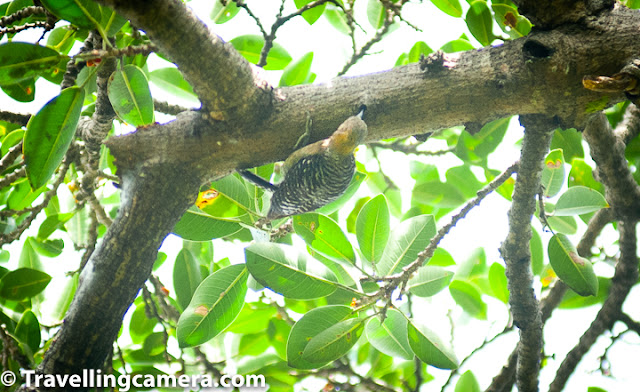 |
| Hoffman's Woodpecker Related Blog-post from Costa Rica - Travel Guide for Monteverde Cloud Forest Reserve, Costa Rica - Pura Vida ! |
Let's start first with the woodpeckers. Costa Rica has about 16 species of Woodpeckers, of which we saw three and were able to click just one. This also turned out to be the most common woodpecker to be spotted on Costa Rica - The Hoffman's Woodpecker. With its yellow nape and striped wings, this woodpecker is fairly easy to spot. We saw this woodpecker hard at work very close to our homestay in Monteverde.
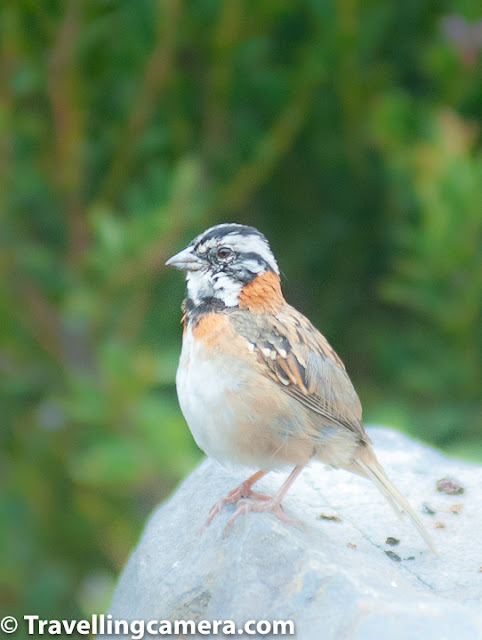 |
| Rufous-Collared Sparrow |
Sparrows, the next species we are going to talk about, are my personal favorite. In fact, back home in India, noisy and daring house sparrows are always welcome in my balcony. There are about 26 species of sparrows and finches in Costa Rica. We were fortunate to come across a few. The most remarkable was the Rufous-Collared Sparrow. This little bird has a white head with black stripes and a pronounced rufous stripe around the neck. Because of this striking coloration, these birds are easy to spot from a distance.
Related Blog-post from Costa Rica - Things not to miss in & around Jaco Town of Costa Rica - Beaches, Birds & Landscapes
 |
| Rufous-Collared Sparrow |
Related Blogpost from Costa Rica : Sunset Hues around Playa Veridor - Beaches around Papagayo Peninsula, Costa Rica
These sparrows are found almost everywhere and aren't intimidated by human presence. It is as commonly sighted in suburban settings as in the urban ones, but is mostly missing from densely forested areas. They feed on seeds, fallen grain, insects, and spiders, and are friendly and versatile.
Related Blog-post from Costa Rica - Travel Guide for Monteverde Cloud Forest Reserve, Costa Rica - Pura Vida !
 |
| Sooty Thrush |
Related Blogpost from Costa Rica - Teatro Nacional de Costa Rica in San Jose City of Costa Rica, Central America
Coming to the thrushes, the Sooty Thrush was earlier known as the Sooty Robin. This bird has a brown body with a belly that is several shades lighter than the wings. It has orange beak, legs and a striking yellow or orange eye ring. With a length of about 25 cm, this is a medium-sized bird and is endemic to Costa Rica and Panama. It feeds on spiders and insects and also on small fruit. preferring to hop around in open areas, this bird is quite easy to spot in Costa Rica.
Related Blog-post from Costa Rica - Incredible Birds of Costa Rica - Part 1 || Hummingbirds
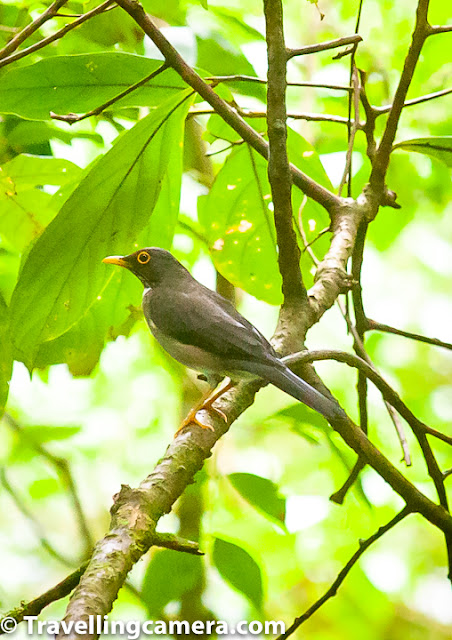 |
| Sooty Thrush |
Related Blogpost from Costa Rica - Hiking around Blanca Beach around Four Seasons Resort in Papagayo Peninsula, Costa Rica
Sooty Thrush's relative, the Clay-Colored Thrush (locally known as yigüirro), is the national bird of Costa Rica. We did see this bird, but it was at a distance and we were not able to click it. The bird is slightly smaller than the Sooty Thrush and is unremarkable in appearance. This makes one wonder why a country which is as blessed as Costa Rica, when it comes gorgeous birds, would choose such a plain looking bird as its national symbol. Indeed, when it comes to prettiness, the clay-colored thrush looks plain when compared to the Resplendent Quetzal, Orange-bellied Trogon, or the Scarlet Macaw. What makes it special though is its beautiful song, which can be heard even in urban settings, at the start of the rainy season.
Other Blogpost from Costa Rica - Tour of our room at Four Seasons Papagayo Peninsula, Costa Rica
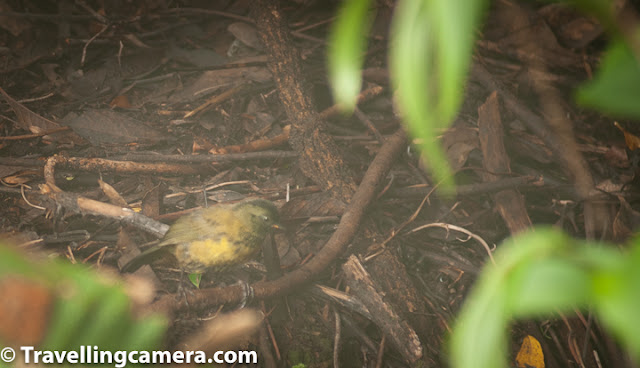 |
| Cape May Warbler |
Other Blogpost from Costa Rica - Tour of our room at Four Seasons Papagayo Peninsula, Costa Rica
A Cape May Warbler was spotted foraging in the undergrowth near the crater of Irazu Volcano. This bird is a rare migrant in Costa Rica and if indeed I have identified the bird correctly then this is one of our most precious photographs from Costa Rica. If this is a Cape May Warbler then it is either a juvenile male or an adult female. The adult male has a striking green back, tiger-like stripes on the chest and a very prominent chestnut cheek patch. It feeds on caterpillars and is also known to sip nectar from flowers or even from hummingbird feeders.
Related Blog-post from Costa Rica - Travel Guide for Monteverde Cloud Forest Reserve, Costa Rica - Pura Vida !
 |
| Blue-Gray Tanager |
Related Blog-post from Costa Rica - Things not to miss in & around Jaco Town of Costa Rica - Beaches, Birds & Landscapes
Speaking of Tanagers, we were lucky enough to spot three different varieties of these beautiful birds. The one that was easiest to spot was the blue-gray tanager, which we spotted on our way to Jaco beach and also in Monteverde. This bird is one of the prettiest we saw in Costa Rica. I especially loved its icy blue coloration. The bird is usually found in pairs or small flocks and feeds mainly on ripe fruit. However, it is also known to consume insects and nectar.
Related Blogpost from Costa Rica - Snorkeling & Catamaran ride in Pacific Ocean, Costa Rica
 |
| Blue-Gray Tanager
Related Blogpost from Costa Rica - Snorkeling & Catamaran ride in Pacific Ocean, Costa Rica
|
These birds like to nest in semi-open areas and are usually not found in dense forests. They are known to live in parks, forest edges, on roadside trees, and along the rivers. This versatile bird is bold and does not hesitate in nesting close to human population.
Related Blogpost from Costa Rica - Incredible Birds of Costa Rica - Part 2 || Motmots, Toucans, Trogons, Quetzals, and Macaws
 |
| Spangle-Cheeked Tanager |
A remarkable medium-sized bird, the spangle-cheeked tanager is a resident-breeder in Costa Rica. It is usually found in the highlands - at the edge of forests and in semi-open areas. It is usually found in pairs or even in mixed-family feeding flocks. It has dark head, throat, and upperparts. There is a blue-scaling on the breast and wings and tail has blue edging. Its belly is mostly rufous. It feeds on small fruit and also on insects and spiders. Both male and female are quite similar but the blue scaling in males is more pronounced that that in the females.
 |
| Sooty-capped Bush Tanager |
Another resident breeder in Costa Rica, the Sooty-Capped Bush Tanager has a gray head and yellow or olive upperparts and body. The belly is mostly white. Like the Blue-Gray Tanager and the Spangle-cheeked tanager, the sooty-capped bush tanager also likes to live in clearings close to the forests. They are found in mossy mountain forests and likes to feed on small fruit, insects, and spiders. They are often found in small groups or in mixed-species feeding flocks.
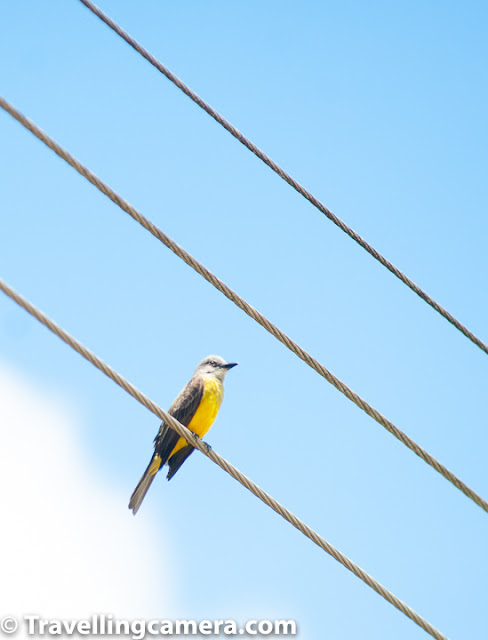 |
| Tropical Kingbird |
The Tropical Kingbird is a kind of tyrant flycatcher that can often be found perched on tree tops and electric cables watching out for possible prey. Once it spots a tasty-looking insect, the kingbird executes stupendous acrobatics to catch the unsuspecting insect. The bird has gray head with a dark eye mask. Its wings and forked tail are brown. Fiercely territorial in nature, the Tropical Kingbird is known for valiantly defending its territory against much larger intruders, such as toucans.
 |
| Blue-and-white Swallow |
The Blue-and-White Swallow can often be seen perched on electric cables. Often seen in small groups, the bird survives mostly on a diet of insects that it catches mid-air. The birds can be seen flying at high speeds and taking sharp turns to catch insects. The bird is identifiable because of its dark blue upperparts, a white neck and belly, and a forked tail. This is one species that has benefited because of deforestation, as it has led to an increase in the suitable habitat.
 |
| Orange-fronted Parakeet |
We spotted orange-fronted parakeets in Monteverde town. This was a large flock with close to 50 birds. This is not surprising because these parakeets are known to stay in large flocks, some as large as 100 birds. These parakeets are easily recognizable because of its blue crown, blue wings and a blue tail tip. It has an orange forehead and a bright yellow ring around the eye. The bird feeds on seeds, flowers, and fruits. Though the bird is not yet endangered, its numbers have gone down because of illegal pet trade.
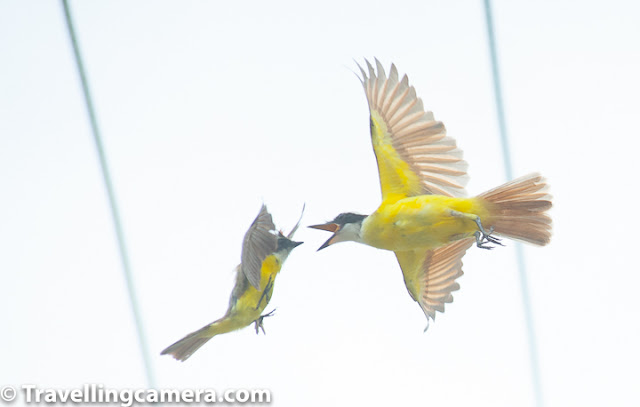 |
| Great Kiskadees having a discussion mid-air |
Boisterous and fearless, the Great Kiskadee is a tyrant flycatcher and can easily be spotted in various parts of Costa Rica. We saw it near Irazu Volcano and also in Monteverde. This is a large flycatcher, but is easily confused with lookalikes such as the social flycatcher and the boat-billed flycatcher. It is distinguishable because of a hint of red in its wings.
The last bird we will talk about in this post is the white-naped brush finch. The finch is identifiable by the yellow patch on its throat and a white line in the middle of its head. Its belly is gray or white and in some subspecies, it may also be yellow. It forages on the ground, in the undergrowth, and is often seen in small family groups.
We will talk about a few more birds we came across in Costa Rica in the last post in this series. Stay tuned.
 |
| Blue-Throated Toucanet |
One of the reasons I was really excited about Costa Rica was its birds. From what I had read, I pictured a Utopian world where colorful birds would be flying over our heads, singing beautiful songs. My imagination had built all this up to the extent that I was afraid that I would be disappointed upon getting there.
When we landed in San Jose, I was hoping to start seeing these exotic birds immediately. And we were in fact greeted by three different songs. It took us a few minutes to figure out the source of the songs. And one by one we managed to trace the songs to the singers. The trail, however, all led to one single source - the Great-Tailed Grackle, also known as the Zanate. This versatile bird is often considered a pest because of its loud vocalizations and craftiness. It feeds on grains and can damage agriculture. However, the San Jose city was musical because of the songs of this bird. While there were a few other birds too, the Grackle by far overshadowed them.
 |
| Great-tailed Grackle |
It was when we went to the Irazu volcano, when we saw a variety of birds, including a bunch of hummingbirds. We have already talked about the hummingbirds at length in another post. Here we will talk about other birds. Let's start with the Motmots. These colorful birds belong to the same family of birds as the kingfishers, bee-eaters, and rollers. These birds are a common sight in Costa Rica and you will often find them sitting on the power lines along the roads. The birds nest on the ground and are seen as commonly in the cities as in the forests. And since these birds are not too timid, we managed to capture some good pictures. One particular motmot, in fact, came and sat very close to the trail we were following in Monteverde and struck some beautiful poses.
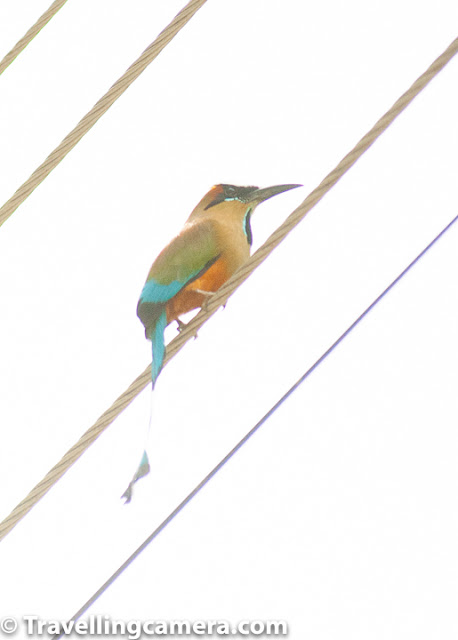 |
| Turquoise-Browed Motmot |
In Costa Rica, we saw two types of Motmots in San Jose as well as in Monteverde - the turquoise-browed motmot and the blue-diademed motmot (also known as Lesson's Monteverde). Both these species have a racket tail, making them quite easy to identify even from a distance. The Turquoise-browed motmot has tail feathers that are bright blue and black in both female and male. In the male motmot, this tail is often the key to success in mating, whereas both male and female motmots also use a wag-display motion to warn of the presence of predators.
 |
| Turquoise-Browed Motmot (seems to have lost its raquet tail) |
The Turquoise-browed motmot's body is mostly green-blue with rufus back and belly. It has a turquoise blue patch on head and cheek. This is a medium-sized bird that feeds on insects and small reptiles. Poison-dart frogs also find themselves being ingested by these birds.
 |
| Blue-Diademed Motmot (Lesson's Motmot) |
The blue-diademed motmot has a blue-green body. It wears a black mask with bright-blue band around it. The blue-diademed motmot is a little harder to sight than the Turquoise-browed motmot because it likes to dwell in dense forests. The tail racquets too are smaller and less dramatic than those of the Turquoise-browed motmot.
Related Blogpost from Costa Rica - Teatro Nacional de Costa Rica in San Jose City of Costa Rica, Central America
 |
| Blue-Throated Toucanet |
Next, let's talk about the toucans and toucanets. While we were only able to see one single toucan, that also from a distance, we were especially lucky when it comes to sighting toucanets. On our very first day in Monteverde, Toucanets made an appearance right outside our homestay. These turned out to be the blue-throated toucanets.
Related Blog-post from Costa Rica - Incredible Birds of Costa Rica - Part 1 || Hummingbirds
 |
| Emerald Toucanet |
The bill is large, though much smaller than that of a toucan. The upper mandible is part yellow. They have a blue patch around the base of the beak and the throat. The body is various shades of green. The vent and tips of the tail are rufus. We again came across toucans inside the Monteverde cloud forest. This time it was most probably the emerald toucanet, though we could not be sure because these were moving about very fast and were at a distance.
Related Blogpost from Costa Rica - Hiking around Blanca Beach around Four Seasons Resort in Papagayo Peninsula, Costa Rica
 |
| Orange-Bellied Trogon |
Trogons were another species of birds that we came across in Costa Rica. We saw this bird in Monteverde as well as in Papagayo peninsula. The bird is large and has an orange belly. This was earlier categorized as a subspecies of the collared trogon, but is now considered a morph instead. The only characteristic that can be used to differentiate between the orange-bellied trogon and the collared trogon is the color of the belly. It is lighter in orange-bellied trogon and much brighter in collared. The neck and back of the orange-bellied trogon is blue-green.
Other Blogpost from Costa Rica - Tour of our room at Four Seasons Papagayo Peninsula, Costa Rica
 |
| Resplendent Quetzal (Male) |
Another bird of the trogon family that we were fortunate enough to sight was the Resplendent Quetzal. This bird needs no introduction. This bird attracts myths and tourists alike. You may find this difficult to believe, but you only have to see this bird once to know what I mean. The bird's plumage is such that it seems to change colors in different lights. The male is so splendidly colored that it is difficult to believe that such a bird can exist.
Related Blog-post from Costa Rica - Travel Guide for Monteverde Cloud Forest Reserve, Costa Rica - Pura Vida !
 |
| Male Resplendent Quetzal at its man-made nest |
We were hoping that we would run into this bird in the cloud forest of Monteverde. Our time in the reserve was almost about to end and we were fast losing hope, when I decided to ask a random tourist whether they had had the opportunity to sight the Resplendent Quetzal. And that gentleman broke into a wide smile and shared a photograph that he had managed to click. The sighting had happened a at a short distance from where we were standing. He gave us detailed instructions about how to get there.
Related Blog-post from Costa Rica - Things not to miss in & around Jaco Town of Costa Rica - Beaches, Birds & Landscapes
 |
| Resplendent Quetzal (Female) |
We reached the spot and were able to see the nest. However, the Quetzals (male or female), were nowhere to be seen. We waited around the area for about 1.5 hours when we saw first the female and then the splendid male. Quetzals are attentive parents and do not leave their nests unattended for too long. We knew this and were confident that we would be able to see them. And thank God we were not disappointed. One of the main reasons to go to Monteverde was to see this bird. Our goal was reached.
Related Blogpost from Costa Rica - Snorkeling & Catamaran ride in Pacific Ocean, Costa Rica
 |
| Female Resplendent Quetzal at the nest |
During our day excursion to the Jaco beach, we were fortunate enough to see the Scarlet Macaw. As is common, we heard the bird before we saw it. Its rude screech made us stop in our tracks and search the canopies overhead. Despite its bright red, blue, and yellow plumage, it wasn't easy to sight this bird. It was out their in plain sight and still managed to camouflage itself. But our patience was rewarded and we soon saw this big parrot looking down at us. Clicking a good photo was another challenge and our camera didn't help much. We did the best we could and moved on.
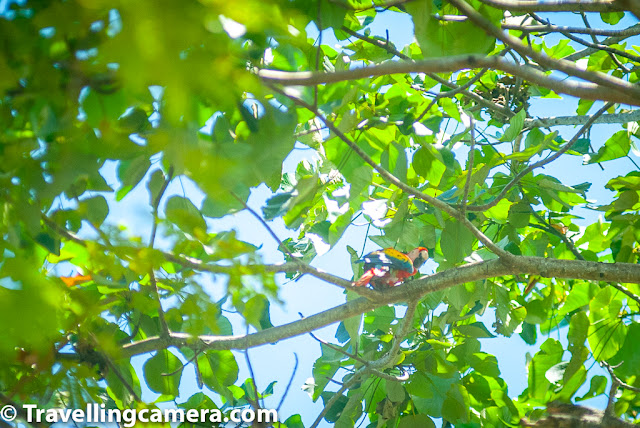 |
| Scarlet Macaw looking down upon us |
In this part, we have mostly talked about the bigger birds so far, but Costa Rica is home to some really beautiful smaller birds. We will talk about those in the next post. In the meanwhile, we will look forward to your comments on this. And if we have made a mistake in identifying any birds, please do feel free to correct us.
 |
| Scarlet Macaw taking a flight |
 |
| Bananaquit |
Costa Rica is indeed a birders' paradise. With 919 registered species as of November 2018, the country has a vast variety of species spread everywhere. Many of these are colorful and incredibly beautiful. They come in all sizes and some have calls that are musical, others sing haunting songs. If you happen to go into a cloud forest, you can hear a three-wattled bellbird's bell-like call echoing around. However, it is not easy to spot this bird. We couldn't either, though we heard it everywhere.
 |
| Gray-capped flycatcher |
With nearly 75 species of Tyrant flycatchers and 4 more of Royal flycatchers, you cannot go anywhere in Costa Rica without coming across at least 5 different types. We have already covered the Great Kiskadee and Western Kingbird in the previous post of this series. In this post, we will talk about two more types - the gray-capped flycatcher and the golden-bellied flycatcher. The gray-capped flycatcher is a member of the Tyrant flycatcher family, and is visually very similar to the social flycatcher. In fact the gray-capped flycatcher at times uses the nests abandoned by social flycatchers. The nesting sites are either close to or over water bodies, where food is abundant.
 |
| Golden-bellied flycatcher |
Another tyrant flycatcher, the golden-bellied flycatcher is also known as the golden-bellied greygone. found at the edge of wet forests in the highlands. the golden-bellied flycatcher usually perches on high tree canopies or power cables and catches insects in mid-air. However, it also feeds on a variety of other stuff such as berries.
 |
| Brown Jay |
In this photograph, a brown jay is perched on a leafless branch. The jay belongs to the same group as magpies, but has shorter tail and larger bill than magpies. Most adults have black bills, brown wings and lighter (often white) lower parts. The brown jays eat a variety of food - insects, seeds, lizards. They are also known to raid nests and take eggs and baby birds, if other kind of food is scarce.
 |
| Slate-throated whitestart |
The slate-throated whitestart is a long-tailed warbler with yellow underparts, white rump and very dark, almost black head and shoulders. It has a red patch on its head, which is not visible in this photograph. It was because of this that it was so difficult for me to identify this bird. There are too many yellow and dark brown birds in Costa Rica. The whitestart, much like the redstarts, moves its tails up and down to scare insects and then catches them midair.
 |
| Costa Rican Warbler |
Another warbler we saw was the Costa Rican Warbler or the black-eared warbler is a small bird, with brown wings and black patches on the cheeks. It is a small bird that feeds on insects that it forages for on the ground. Pairs and small groups of Costa Rican Warbler is often found in mixed species flocks.
 |
| Black-faced solitaire |
Black-faced solitaire is a bird belonging to the thrush family. Easily identifiable with a black face and orange beak and legs, the black-faced solitaire forages for berries and also insects. The black-faced solitaire lives in dense undergrowth and bamboo clumps in the cloud forests.
 |
| Yellow-olive flatbill |
The Yellow-Olive flatbill is another tyrant flycatcher which was very difficult for me to identify. Even now, I am not sure whether I have identified the bird correctly. Please see if I have made a mistake here. This flycatcher is found across a wide range in central and south America.
 |
| Bananaquit |
A Bananaquit is a small bird that feeds on nectar. It is yet to be properly categorized, though has tentatively been put under the Tanager family. This little bird is found in warmer parts of the Americas. The bird has a sharp, pointed beak that it uses to pierce flowers from the side to drink nectar. It also uses the beak to pierce fruits and sip on their juices. The little bird is also known to eat insects at times. It occurs in semi-open habitats and is known to reside in gardens and parks. The bird is however usually not found in dense forests.
 |
| Great egret |
This graceful bird, once endangered, is now a common sight in American wetlands. It can often be seen standing still in water, waiting for fish to get close enough so that it can strike and make a kill. The bird is also known to swim and dip to catch fish at times. The great egret turns even more spectacular during the breeding season, when it develops a bright green patch on its beak and beautiful long plumes that shed once the breeding season is over.
 |
| Slaty flowerpiercer |
The Slaty flowerpiercer is often grouped along with the bananaquit, but is essentially a different bird. The bird has a pointed bill with hooked upper mandible. It uses this bill to pierce the base of flowers and then extracts nectar with its tongue. It also feeds on small insects. The flowerpiercer faces stiff competition from hummingbirds who often chase it out of their territory.
With so many fascinating birds, it is definitely tempting to go back to Costa Rica for a second visit, though this time we would want to spend more time close to birding sites. However, Costa Rica is really far and there are other constraints too. May be one day...
Related Blogposts -


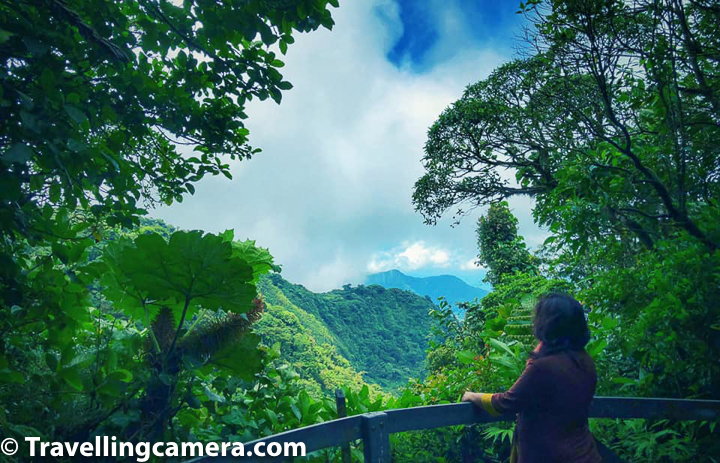
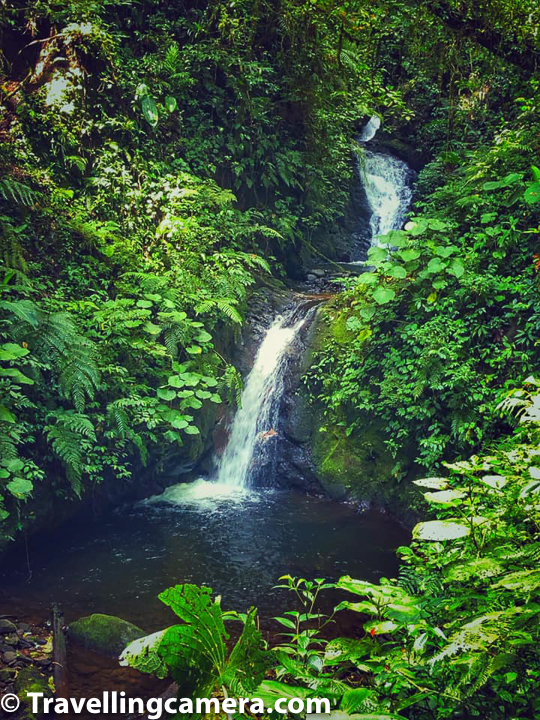

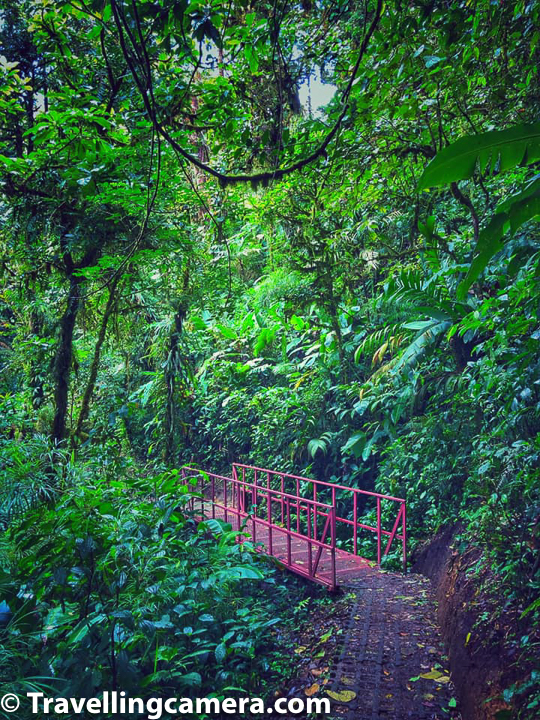

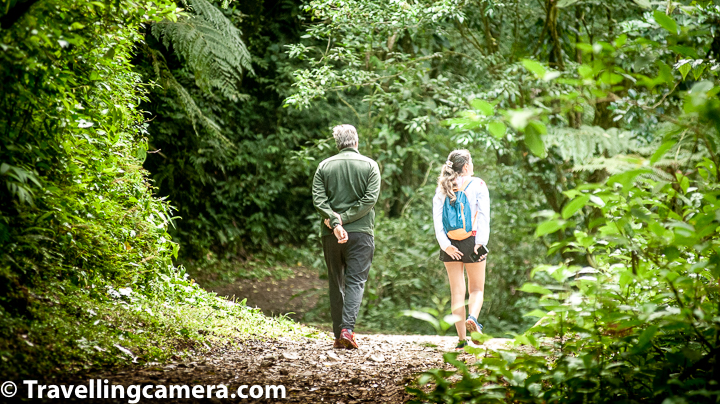


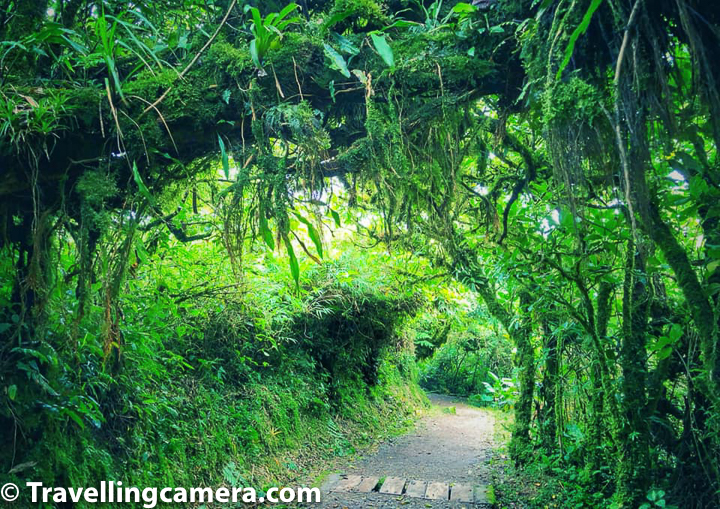

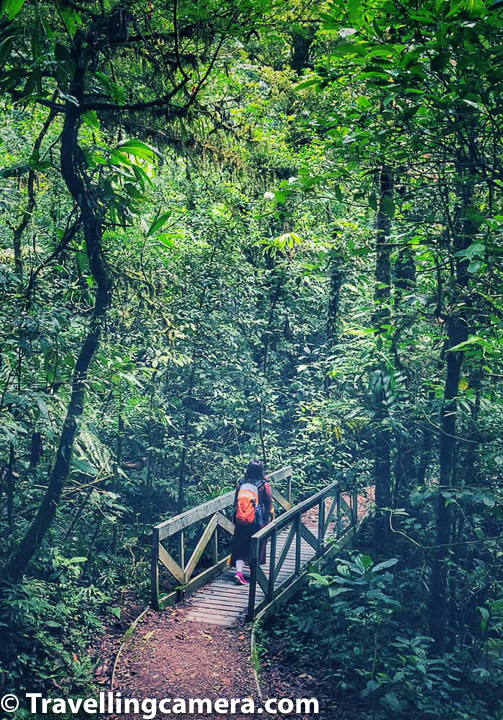

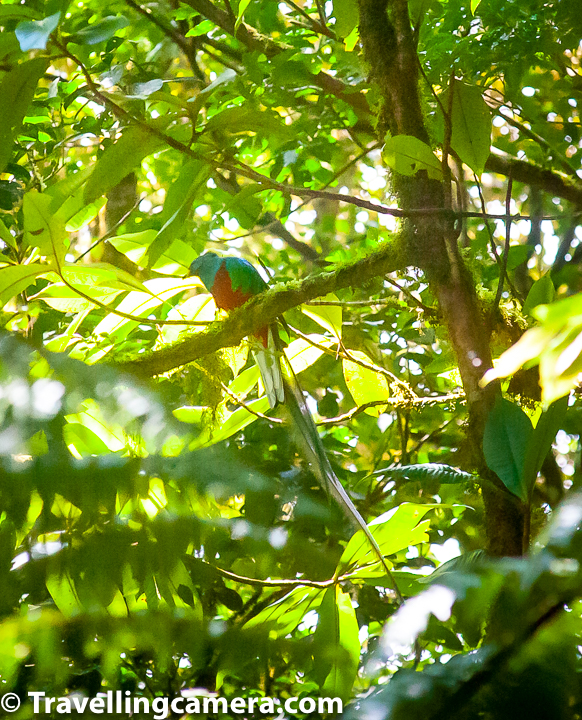



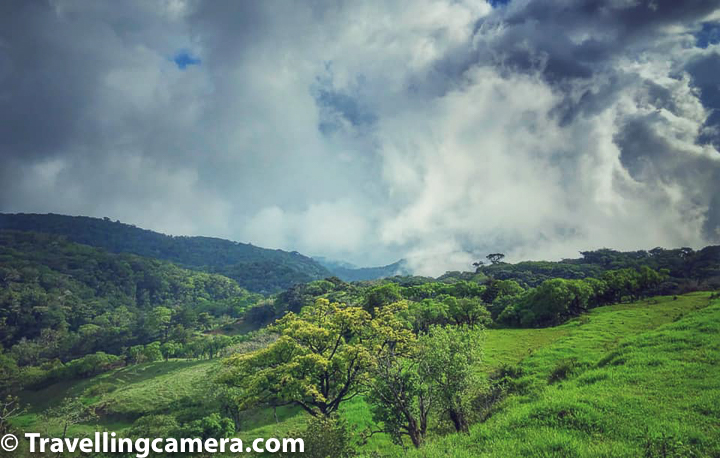





























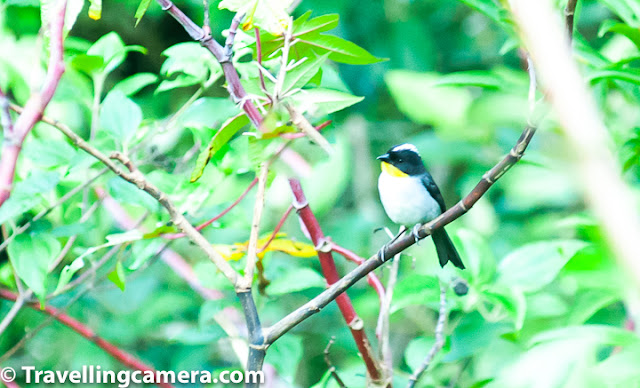







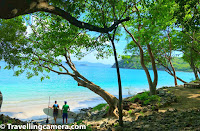
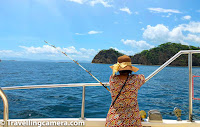





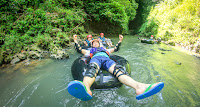



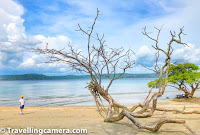

.jpg)